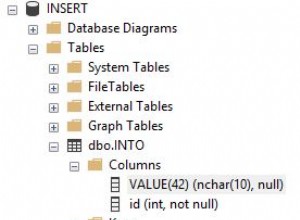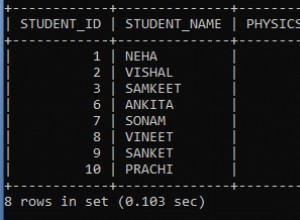Tùy chọn 1
Đây có lẽ là một công việc cho PL / SQL. Bắt đầu với các kiểu dữ liệu để xuất:
CREATE TYPE supply_details_obj AS OBJECT(
product_id NUMBER,
quantity NUMBER,
supplier_id NUMBER,
customer_id NUMBER
);
CREATE TYPE supply_details_tab AS TABLE OF supply_details_obj;
Sau đó, chúng ta có thể xác định một hàm pipelined để đọc INVENTORY_IN và INVENTORY_OUT các bảng một hàng tại một thời điểm và hợp nhất hai hàng để giữ tổng số hàng tồn kho còn lại hoặc số lượng cần cung cấp đang hoạt động:
CREATE FUNCTION assign_suppliers_to_customers (
i_product_id IN INVENTORY_IN.PRODUCT_ID%TYPE
)
RETURN supply_details_tab PIPELINED
IS
v_supplier_id INVENTORY_IN.SUPPLIER_ID%TYPE;
v_customer_id INVENTORY_OUT.CUSTOMER_ID%TYPE;
v_quantity_in INVENTORY_IN.IN_QUANTITY%TYPE := NULL;
v_quantity_out INVENTORY_OUT.OUT_QUANTITY%TYPE := NULL;
v_cur_in SYS_REFCURSOR;
v_cur_out SYS_REFCURSOR;
BEGIN
OPEN v_cur_in FOR
SELECT in_quantity, supplier_id
FROM INVENTORY_IN
WHERE product_id = i_product_id
ORDER BY inv_timestamp;
OPEN v_cur_out FOR
SELECT out_quantity, customer_id
FROM INVENTORY_OUT
WHERE product_id = i_product_id
ORDER BY inv_timestamp;
LOOP
IF v_quantity_in IS NULL THEN
FETCH v_cur_in INTO v_quantity_in, v_supplier_id;
IF v_cur_in%NOTFOUND THEN
v_supplier_id := NULL;
END IF;
END IF;
IF v_quantity_out IS NULL THEN
FETCH v_cur_out INTO v_quantity_out, v_customer_id;
IF v_cur_out%NOTFOUND THEN
v_customer_id := NULL;
END IF;
END IF;
EXIT WHEN v_cur_in%NOTFOUND AND v_cur_out%NOTFOUND;
IF v_quantity_in > v_quantity_out THEN
PIPE ROW(
supply_details_obj(
i_product_id,
v_quantity_out,
v_supplier_id,
v_customer_id
)
);
v_quantity_in := v_quantity_in - v_quantity_out;
v_quantity_out := NULL;
ELSE
PIPE ROW(
supply_details_obj(
i_product_id,
v_quantity_in,
v_supplier_id,
v_customer_id
)
);
v_quantity_out := v_quantity_out - v_quantity_in;
v_quantity_in := NULL;
END IF;
END LOOP;
END;
/
Sau đó, đối với dữ liệu mẫu:
CREATE TABLE INVENTORY_IN ( ID, INV_TIMESTAMP, PRODUCT_ID, IN_QUANTITY, SUPPLIER_ID ) AS
SELECT 0, TIMESTAMP '2021-03-09 00:00:00', 101, 20, 0 FROM DUAL UNION ALL
SELECT 1, TIMESTAMP '2021-03-10 01:00:00', 101, 100, 4 FROM DUAL UNION ALL
SELECT 2, TIMESTAMP '2021-03-11 02:00:00', 101, 50, 3 FROM DUAL UNION ALL
SELECT 3, TIMESTAMP '2021-03-14 01:00:00', 101, 10, 2 FROM DUAL;
CREATE TABLE INVENTORY_OUT ( ID, INV_TIMESTAMP, PRODUCT_ID, OUT_QUANTITY, CUSTOMER_ID ) AS
SELECT 1, TIMESTAMP '2021-03-10 02:00:00', 101, 30, 1 FROM DUAL UNION ALL
SELECT 2, TIMESTAMP '2021-03-11 01:00:00', 101, 40, 2 FROM DUAL UNION ALL
SELECT 3, TIMESTAMP '2021-03-12 01:00:00', 101, 80, 1 FROM DUAL;
Truy vấn:
SELECT product_id,
supplier_id,
customer_id,
SUM( quantity ) AS quantity
FROM TABLE( assign_suppliers_to_customers( 101 ) )
GROUP BY
product_id,
supplier_id,
customer_id
ORDER BY
MIN( inv_timestamp )
Kết quả đầu ra:
Tùy chọn 2
Một truy vấn SQL (rất) phức tạp:
WITH in_totals ( ID, INV_TIMESTAMP, PRODUCT_ID, IN_QUANTITY, SUPPLIER_ID, TOTAL_QUANTITY ) AS (
SELECT i.*,
SUM( in_quantity ) OVER ( PARTITION BY product_id ORDER BY inv_timestamp )
FROM inventory_in i
),
out_totals ( ID, INV_TIMESTAMP, PRODUCT_ID, OUT_QUANTITY, CUSTOMER_ID, TOTAL_QUANTITY ) AS (
SELECT o.*,
SUM( out_quantity ) OVER ( PARTITION BY product_id ORDER BY inv_timestamp )
FROM inventory_out o
),
split_totals ( product_id, inv_timestamp, supplier_id, customer_id, quantity ) AS (
SELECT i.product_id,
MIN( COALESCE( LEAST( i.inv_timestamp, o.inv_timestamp ), i.inv_timestamp ) )
AS inv_timestamp,
i.supplier_id,
o.customer_id,
SUM(
COALESCE(
LEAST(
i.total_quantity - o.total_quantity + o.out_quantity,
o.total_quantity - i.total_quantity + i.in_quantity,
i.in_quantity,
o.out_quantity
),
0
)
)
FROM in_totals i
LEFT OUTER JOIN
out_totals o
ON ( i.product_id = o.product_id
AND i.total_quantity - i.in_quantity <= o.total_quantity
AND i.total_quantity >= o.total_quantity - o.out_quantity )
GROUP BY
i.product_id,
i.supplier_id,
o.customer_id
ORDER BY
inv_timestamp
),
missing_totals ( product_id, inv_timestamp, supplier_id, customer_id, quantity ) AS (
SELECT i.product_id,
i.inv_timestamp,
i.supplier_id,
NULL,
i.in_quantity - COALESCE( s.quantity, 0 )
FROM inventory_in i
INNER JOIN (
SELECT product_id,
supplier_id,
SUM( quantity ) AS quantity
FROM split_totals
GROUP BY product_id, supplier_id
) s
ON ( i.product_id = s.product_id
AND i.supplier_id = s.supplier_id )
ORDER BY i.inv_timestamp
)
SELECT product_id, supplier_id, customer_id, quantity
FROM (
SELECT product_id, inv_timestamp, supplier_id, customer_id, quantity
FROM split_totals
WHERE quantity > 0
UNION ALL
SELECT product_id, inv_timestamp, supplier_id, customer_id, quantity
FROM missing_totals
WHERE quantity > 0
ORDER BY inv_timestamp
);
Đối với dữ liệu mẫu ở trên, kết quả đầu ra:
db <> fiddle tại đây




